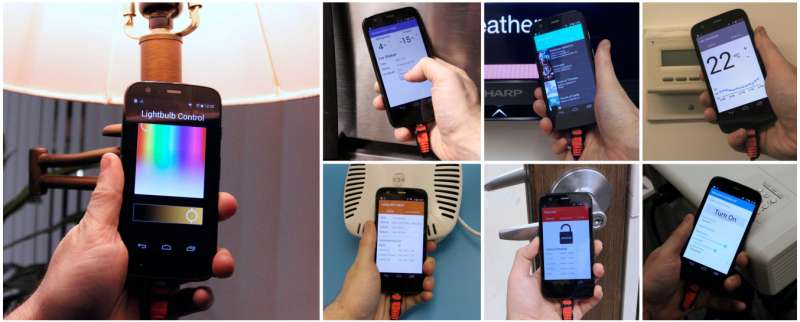May 10, 2017 weblog
Carnegie Mellon team hones tap concept for IoT items, shows prototype phone

(Tech Xplore)—Lights, washing machine, fridge, thermostat, alarms. Just a few of a growling list of smart items that will be able to obey instructions and relay information. Consumers will get deeper enmeshed in the Internet of Things.
One user headache lies ahead, though. The smart life is not automatically the easy life. Welcome to the interaction bottleneck of the future. That bottleneck consists of users and their "ecosystem" of appliances.
Researchers at Carnegie Mellon had that bottleneck in mind.
They can explain just what the problem is about. They consider how "Homes, offices and many other environments will be increasingly saturated with connected, computational appliances, forming the "Internet of Things" (IoT). At present, most of these devices rely on mechanical inputs, webpages, or smartphone apps for control. However, as IoT devices proliferate, these existing interaction methods will become increasingly cumbersome."
Why should a future owner of a smart home have to scroll through pages of apps, just to dim some lights?
The researchers, from the Future Interfaces Group at Carnegie Mellon, have been working on a solution.
Their paper is titled "Deus EM Machina: On-Touch Contextual Functionality for Smart IoT Appliances."
Their solution to the bottleneck in a nutshell is a smartphone that recognizes physical contact with appliances and summons the appropriate interface. Their idea is that the user just has to tap a phone to the appliance to discover and use contextual functionality.
The group posted a video on Monday, and it shows the group's prototype smartphone in action.
Chris Harrison, one of the research member team and co-author of the paper, stated "our prototype smartphone recognizes physical contact with uninstrumented appliances, and summons appliance-specific interfaces. Our user study suggests high accuracy – 98.8% recognition accuracy among 17 appliances. Finally, to underscore the immediate feasibility and utility of our system, we built twelve example applications, including six fully functional end-to-end demonstrations."
They have actually explored two approaches toward mitigating the interaction bottleneck. Approach 1 is to automatically launch manufacturers' applications instantly upon contact with an associated appliance. They show, for example, how touching a phone to the thermostat launches the thermostat's full screen configuration app.
Approach 2 is all about "charms."
They call them "contextual" charms to refer to small widgets that allow the smartphone application to perform actions relevant to the touched appliance. They appear as floating buttons along the right side of an app when the phone touches a supported device. Reading a PDF? Touch the phone to a printer and you see an onscreen print button, for example.
So, in this charm approach, there are buttons to trigger specific actions, phone-to-device. "When reading a document, for example, touch the phone to a printer will reveal an onscreen print button. A user can tap the button to print the onscreen document."
When held to a computer monitor, a charm appears that sends the file to the computer desktop.
What do the authors have to say about the technology at play here? They said the system involves a smartphone which is instrumented with a compact EM sensor.
Signal processing and classification is performed on the phone. Components are powered from the smartphone battery.
Richard Lai in Engadget examined their approach, and wrote that the group "is proposing a working concept that's practically the next evolution of NFC: electromagnetic emissions sensing."
As each piece of electrical device has its own electromagnetic field, the characteristic can be used as an ID so long as the device is not truly powered off, he said.
The authors, meanwhile, noted one problem that is hard to solve, and that is, as with any EM sensing approach, they said, their system was "susceptible to external interference from powerline noise. Such noise can confuse the classifier and decrease accuracy." They said it was a hard problem to solve.
"Future designs should implement strong noise rejection to reject common sources of powerline noise (e.g. high-current devices such as vacuum cleaners), but further work remains to be done."
More information: — chrisharrison.net/index.php/Research/EMPhone
— Xiao, R., Laput, G., Zhang, Y. and Harrison, C. 2017. Deus EM Machina: On-Touch Contextual Functionality for Smart IoT Appliances. In Proceedings of the 35th Annual SIGCHI Conference on Human Factors in Computing Systems (Denver, Colorado, USA, May 6 - 11, 2017). CHI '17. ACM, New York, NY. 4000-4008. chrisharrison.net/projects/emphone/EMPhone.pdf
© 2017 Tech Xplore




















